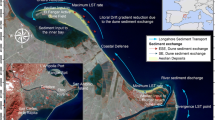Abstract
The proposed model allows the satisfactory reproduction of the changes in the profile geometry in each time step depending on the sediment budgets in a given morphodynamic system. The applied modification to the general Bruun rule governing the conservation of mass must account for the effect of the sediment transport, which is described in terms of the erosion and accretion rates (Er and and Ac, respectively). The scale of the erosion is a function of the total annual wave energy flux reaching the beach. The accretion is governed by the Er, on the one hand, and by the sediment budget in the morphodynamic system, on the other hand. The equilibrium profile obtained for the case of a balanced sediment budget (Er = Ac) shows good agreement with the observed profiles. A deficit or surplus in the sediment budget results in the shoreline’s retreat or advance accompanied by either a decrease or increase in the slope of the bottom profile. The model accounts for different types of shoreline responses to changes in the sea level (the Bruun rule, the development of a coastal barrier, and abrasion). Sediment budget imbalances can be a factor in the profile’s evolution due to changes in the sea level, while the combination of both factors will produce a variety of behaviors of the shoreline, as was shown by our calculations. The model was verified using historical data on the behavior of the Central Holland coast and the Abkhazian coast during the Late Holocene. It was shown that the model satisfactory reproduces the progradation of coastal barriers. An example of a relatively short-term forecast (over a 100-year period) is given.
Similar content being viewed by others
References
Hydrometeorological Conditions of the Shelf Area of the Seas of USSR. The Black Sea (Gidrometeoizdat, Leningrad, 1986), Vol. 4 [in Russian].
V. P. Zenkovich, Principles of the Theory on Marine Coasts Development (AN SSSR, Moscow, 1962) [in Russian].
I. O. Leont’yev, “Modeling of Evolution of Accumulative Coasts of the Barents and Kara Seas,” Geomorphologiya, No. 1, 53–64 (2002).
I. O. Leont’yev, “Forecasting of Coast Evolution Based on Mathematical Modeling,” Okeanologiya, 46, No. 4, 603–611 (2006).
I. O. Leont’yev, “A Budget of Pumps and Forecast of Coast Development,” Okeanologiya, 48, No. 3, 467–476 (2008).
I. O. Leont’yev, D. V. Ryabchuk, M. A. Spiridonov, and D. N. Kurennoi, “Coastal Profile of Eastern Gulf of Finland: The Results of Observation and Modeling of Development in Late Holocene,” Okeanologiya, 50, No. 6, 1034–1044 (2011).
A. V. Porotov and I. O. Leont’yev, “Development of Coastal Area of Sukhumi in Late Holocene,” Okeanologiya, 45, No. 2, 295–303 (2005).
R. A. Bagnold, in The Sea (J. Wiley, New York, 1963) Vol. 3, pp. 507–528.
P. Bruun, “The Broun Rule of Erosion by Sea-Level Rise: A Discussion on Large-Scale Two- and Three-Dimensional Usages,” J. Coastal Res., 4, No. 4, 627–648 (1988).
P. J. Cowell, P. S. Roy, and R. A. Jones, “Simulation of Large-Scale Coastal Change Using a Morphological Behavior Model,” Marine Geol., 126, 45–61 (1995).
I. O. Leont’yev, “Modeling Erosion of Sedimentary Coasts in the Western Russian Arctic,” Coastal Engineering, 47, 413–429 (2003).
A. W. Niederoda, C. W. Reed, D. J. P. Swift, et al., “Modeling Shore-Normal Large-Scale Coastal Evolution,” Marine Geol., 126, 181–199 (1995).
Z. Pruszak, Dynamika brzegu i dna morskiego (Instytut Budownictwa Wodnego PAN, Gdansk, 1998).
B. G. Ruessink and J. H. J. Terwindt, “The Behavior of Nearshore Bars on the Time Scale of Years: A Conceptual Model,” Marine Geol., 163, 289–302 (2000).
M. J. F. Stive and H. J. De Vriend, “Modeling Shoreface Profile Evolution,” Marine Geol., 126, 235–248 (2005).
D. Stolper, J. H. List, and E. R. Thieler, “Simulating the Evolution of Coastal Morphology and Stratigraphy with a New Morphological-Behavior Model (GEOMBEST),” Marine Geol., 218, 17–36 (2005).
J. E. A. Storms, G. J. Weltje, J. J. van Dijke, et al., “Process-Response Modeling of Wave-Dominated Coastal Systems: Simulating Evolution and Stratigraphy on Geological Time Scales,” J. Sedimentary Res., 72, No. 2, 226–239 (2002).
J. E. A. Storms, “Event-Based Stratigraphic Simulation of Wave-Dominated Shallow-Marine Environments,” Marine Geol., 199, 83–100 (2003).
L.C. van Rijn, “Sediment transport and budget of the central coastal zone of Holland,” Coastal Eng., 32, 61–90 (1997).
Author information
Authors and Affiliations
Corresponding author
Additional information
Original Russian Text © I.O. Leont’yev, 2012, published in Okeanologiya, 2012, Vol. 52, No. 4, pp. 588–599.
Rights and permissions
About this article
Cite this article
Leont’yev, I.O. Modeling beach profile evolution at centennial to millennial scales. Oceanology 52, 550–560 (2012). https://doi.org/10.1134/S0001437012040054
Received:
Accepted:
Published:
Issue Date:
DOI: https://doi.org/10.1134/S0001437012040054




